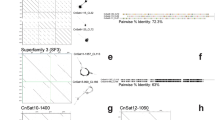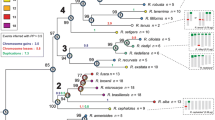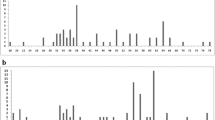Abstract
A basic dichotomy exists in the amount and chromosomal position of constitutive heterochromatin (C-bands) in species of pocket gophers, genus Thomomys. Members of the “talpoides-group” of species (e.g., T. talpoides and T. monticola) have C-bands restricted to the centromeric regions. These taxa are characterized by Robertsonian patterns of karyotypic evolution. In contrast, species within the “bottae-group” are characterized by extensive amounts of heterochromatin, placed as whole-arm and apparent whole-chromosome (T. bottae) or as large interstitial blocks (T. umbrinus). These species are characterized by extensive non-Robertsonian variation in karyotype, variation which may be expressed from local population popymorphism to between population or species polytypy. Within T. bottae, the number of whole-arm heterochromatic autosomes is inversely proportional to the number of uniarmed chromosomes in the complement, which ranges from 0 to 36 across the species populations. In all-biarmed karyotypic populations, upward to 60 percent of the linear length of the genome is composed of heterochromatin. Populations with extensive heterochromatin variation and those with similar amounts meet and hybridize freely in nature. The implications of these data for current ideas on the function of heterochromatin, particularly as related to speciation models, are discussed.
Similar content being viewed by others
References
Arnason, U.: Comparative chromosome studies in Cetacea. Hereditas (Lund) 77, 1–36 (1974)
Baker, R.J., Barnett, R.K., Greenbaum, I.F.: Chromsomal evolution in grasshopper mice (Onychomys: Cricetidae). J. Mammal. 60, 297–306 (1979)
Baverstock, P.R., Watts, C.H.S., Hogarth, J.T.: Heterochromatin variation in the Australian rodent Uromys caudimaculatus. Chromosoma (Berl.) 57, 397–403 (1976)
Baverstock, P.R., Watts, C.H.S., Hogarth, J.T.: Chromosome evolution in Australian rodents II. The Rattus group. Chromosoma (Berl.) 61, 227–241 (1977)
Bradshaw, W.N., Hsu, T.C.: Chromosomes of Peromyscus (Rodentia, Cricetidae) III. Polymorphism in Peromyscus maniculatus. Cytogenet. 11, 436–451 (1972)
Corneo, G.: Do satellite DNAs function as sterility barriers in eukaryotes? Evol. Theory 1, 261–265 (1976)
Craig-Holmes, A.P., Shaw, M.W.: Polymorphism of human constitutive heterochromatin. Science 174, 702–704 (1971)
Duffey, P.A.: Chromosome variation in Peromyscus: a new mechanism. Science 176, 1333–1334 (1972)
Engstrom, M.D., Dowler, R.C., Rogers, D.S., Schmidly, D.S., Bickham, J.W.: Chromosomal variation within four species of harvest mice (Reithrodontomys). J. Mammal. 62, 159–164 (1981)
Fry, K., Salser, W.: Nucleotide sequences of HS-α satellite DNA from Kangaroo Rat Dipodomys ordii and characterisation of similar sequences in other rodents. Cell 12, 1069–1084 (1977)
Hatch, F.T., Bodner, A.J., Mazrimas, J.A., Moore, D.H., II.: Satellite DNA and cytogenetic evolution. DNA quantity, satellite DNA and karyotypic variations in kangaroo rats (genus Dipodomys). Chromosoma (Berl.) 58, 155–168 (1976)
John, B., Miklos, G.L.G.: Functional aspects of satellite DNA and heterochromatin. Int. Rev. Cytol. 58, 1–114 (1979)
King, M.: C-banding studies on Australian hylid frogs: secondary constriction structure and the concept of euchromatin transformation. Chromosoma (Berl.) 80, 191–217 (1980)
Lee, M.R., Elder, F.F.B.: Yeast stimulation of bone marrow mitoses for cytogenetic investigations. Cytogenet. Cell Genet. 26, 36–40 (1980)
Mascarello, J.T., Hsu, T.C.: Chromosome evolution in woodrats, genus Neotoma (Rodentia: Cricetidae). Evolution (Lawrence, Kansas) 30, 152–169 (1976)
Mascarello, J.T., Mazrimas, J.A.: Chromosomes of antelope squirrels (genus Ammospermophilus): a systematic banding analysis of four species with unusual constitutive heterochromatin. Chromosoma (Berl.) 64, 207–217 (1977)
Mazrimas, J.A., Hatch, F.T.: Similarity of satellite DNA properties in the order Rodentia. Nucleic Acid Res. 4, 3215–3227 (1977)
Miklos, G.L.G., Willcocks, D.A., Baverstock, P.R.: Restriction endonuclease and molecular analyses of three rat genomes with special reference to chromosome rearrangement and speciation problems. Chromosoma (Berl.) 76, 339–363 (1980)
Ohno, S., Weiler, C., Poole, J., Christian, L., Stenius: Autosomal polymorphism due to pericentric inversions in the deer mouse (Peromyscus maniculatus) and some evidence of somatic segregation. Chromosoma (Berl.) 18, 177–187 (1966)
Pathak, S., Wurster-Hill, D.H.: Distribution of constitutive heterochromatin in carnivores. Cytogenet. Cell Genet. 18, 245–254 (1977)
Pathak, S., Hsu, T.C., Arrighi, F.E.: Chromosomes of Peromyscus (Rodentia, Cricetidae). IV. The role of heterochromatin in karyotype evolution. Cytogenet. Cell Genet. 12, 315–326 (1973)
Patton, J.L.: Chromosome studies of certain pocket mice, genus Perognathus (Rodentia: Heteromyidae). J. Mammal. 48, 27–37 (1967)
Patton, J.L.: Karyotypic variation following an elevational gradient in the pocket gopher, Thomomys bottae grahamensis Goldman. Chromosoma (Berl.) 31, 41–50 (1970)
Patton, J.L.: Possible genetic consequences of meiosis in pocket gopher (Thomomys bottae) populations. Experientia (Basel) 27, 593–595 (1972a)
Patton, J.L.: Patterns of geographic variation in karyotype in the pocket gopher, Thomomys bottae (Eydoux and Gervais). Evolution (Lawrence, Kansas) 26, 574–586 (1972b)
Patton, J.L.: An analysis of natural hybridization between the pocket gophers, Thomomys bottae and Thomomys umbrinus, in Arizona. J. Mammal. 54, 561–584 (1973)
Patton, J.L.: B-chromosome systems in the pocket mouse, Perognathus baileyi: meiosis and C-band studies. Chromosoma (Berl.) 60, 1–14 (1977)
Patton, J.L.: Chromosomal and genic divergence, population structure, and speciation potential in Thomomys bottae pocket gophers. In: Ecologia y genetica de la especiacion animal (O.A. Reig, ed.), pp. 255–295. Caracas, Venezuela: Equinoccio 1981
Patton, J.L., Dingman, R.E.: Chromosome studies of pocket gophers, genus Thomomys. II. Variation in T. bottae in the American Southwest. Cytogenet. 9, 139–151 (1970)
Patton, J.L., Feder, J.H.: Genetic divergence between populations of the pocket gopher, Thomomys umbrinus (Richardson). Z. Säugetier. 43, 12–30 (1978)
Patton, J.L., Smith, M.F.: Molecular evolution in Thomomys pocket gophers: phyletic systematics, paraphyly, and rates of evolution. J. Mammal. 62, 493–500 (1981)
Patton, J.L., Yang, S.Y.: Genetic variation in Thomomys bottae pocket gophers: macrogeographic patterns. Evolution (Lawrence, Kansas) 31, 697–720 (1977)
Patton, J.L., Hafner, J.C., Hafner, M.S., Smith, M.F.: Hybrid zones in Thomomys bottae pocket gophers: genetic, phenetic, and ecologic concordance patterns. Evolution (Lawrence, Kansas) 33, 860–876 (1979)
Popescu, N.C., DiPaolo, J.A.: Chromosomal interrelationships of hamster species of the genus Mesocricetus. Cytogenet. Cell Genet. 28, 10–23 (1980)
Robbins, L.W., Baker, R.J.: C- and G-band studies on the primitive karyotype for Reithrodontomys. J. Mammal. 61, 708–714 (1980)
Sen, S., Sharma, T.: Quantitative variation of “Mus musculus-like” constitutive heterochromatin and satellite DNA-sequences in the genus Mus. Chromosoma (Berl.) 81, 393–402 (1980)
Sherwood, S.W., Patton, J.L.: Genome evolution in pocket gophers (genus Thomomys) II. Variation in cellular DNA content. Chromosoma (Berl.) (in press, 1982)
Smith, M.F., Patton, J.L.: Relationships of pocket gopher (Thomomys bottae) populations of the lower Colorado River. J. Mammal. 61, 681–696 (1980)
Smith, M.F., Patton, J.L., Hafner, J.C., Hafner, D.J.: Thomomys bottae pocket gophers of the central Rio Grande Valley, New Mexico: local differentiation, gene flow, and historical biogeography. SW Naturalist (in press, 1982)
Sumner, A.T.: A simple technique for demonstrating centromeric heterochromatin. Exp. Cell Res. 75, 304–306 (1972)
Thaeler, C.S., Jr.: Karyotypes of sixteen populations of the Thomomys talpoides complex of pocket gophers (Rodentia-Geomyidae). Chromosoma (Berl.) 25, 172–183 (1968)
Thaeler, C.S., Jr.: Chromosome numbers and systematic relations in the genus Thomomys (Rodentia: Geomyidae). J. Mammal. 61, 414–422 (1980)
Yoon, J.S., Richardson, R.H.: A mechanism of chromosomal rearrangements: the role of heterochromatin and ectopic joining. Genetics 88, 305–316 (1978)
Yunis, J.J., Yasmineh, W.G.: Heterochromatin, satellite DNA, and cell function. Science 174, 1200–1209 (1971)
Author information
Authors and Affiliations
Rights and permissions
About this article
Cite this article
Patton, J.L., Sherwood, S.W. Genome evolution in pocket gophers (genus Thomomys). Chromosoma 85, 149–162 (1982). https://doi.org/10.1007/BF00294962
Received:
Issue Date:
DOI: https://doi.org/10.1007/BF00294962




